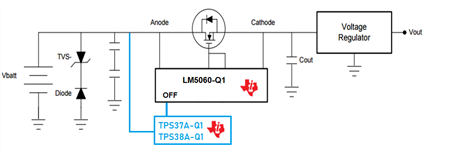The 12-V lead-acid battery is a staple in automotive electronic systems such as automotive cockpits, clusters, head units and infotainment. Monitoring the battery voltage is necessary in order to maintain and support the power requirements of the modern vehicle. Although automotive batteries can withstand wide voltage transients that exceed their nominal voltage during load-dump and cold-crank conditions, what is considered an acceptable operating voltage range changes, and each automotive manufacturer has their own specification that goes beyond the International Organization for Standardization (ISO) 26262 standard. In this technical article, I’ll go over how to manage load-dump and cold-crank conditions, and how to use hysteresis to prevent false system resets.
Managing transients during load-dump conditions
An automotive 12-V battery is nominally specified to operate between 9 V and 16 V. Variations outside of this range increase during conditions known as load dump and cold crank. The ISO 26262 standard, a functional safety standard for automotive electric and electronic systems, describes the expected range of these voltages.
In the load-dump event illustrated in Figure 1, the alternator, designated with the letter A, is abruptly disconnected from the battery because of mechanical vibration, a loose terminal or corrosion at the terminal. The event can cause a battery-voltage transient as high as 60 V for nearly 500 ms.
Figure 1: Load-dump and transient characteristics
Automotive manufacturers can implement overvoltage protection, which will disconnect vital systems from a load-dump event; see Figure 2. Setting a trip point will disconnect the supply source from the electronic subsystem and reconnect the supply after a fixed delay, once the transient voltage settles within a normal operating range. A high-side protection controller such as the LM5060-Q1 needs a disable and enable external signal, which may require a complex design that includes discrete components or a microcontroller.
High-voltage supervisors such as the TPS37A-Q1 and TPS38A-Q1 operate up to 65 V, simplifying designs by directly connecting to the battery and withstanding a load-dump transient voltage. The TPS37A-Q1 and TPS38A-Q1 also give automotive manufactures flexibility by providing a programmable reset delay through an external capacitor, which delays the turn-on of the LM5060-Q1, thus helping protect downstream subsystems from an overvoltage event by allowing an additional reset delay time for the supply voltage to settle.
Figure 2: An overvoltage protection circuit
Effectively dealing with cold-crank conditions
During cold-crank, the starter draws more current and pulls the battery voltage down, sometimes as low as 3 V for 15 ms. Cold-crank conditions are occurring more frequently in modern automobiles as manufacturers adopt systems such as start-stop, a hybrid design that disengages the combustion engine when the vehicle is not in motion (stopped at a traffic light, for example) to improve fuel economy. Start-stop functionality necessitates continuous monitoring of the battery voltage while consuming the least amount of power to ensure that the downstream system is properly initialized and devices remain in a valid state. The TPS37A-Q1 and TPS38A-Q1 voltage supervisors are a good fit for cold-crank conditions because their minimum operating voltage is 2.7 V; additionally, their maximum quiescent current of 2 µA helps manufacturers minimize power losses.
Using hysteresis to prevent false resets in a system
Despite the nominal operating range of 9 V to 16 V, automotive manufacturers specify their own “out of operating voltage range” limits for automotive batteries. Most voltage supervisors used for monitoring have a narrow operating range (i.e. 3 V to 5 V) within those limits, necessitating the use of multiple devices or discrete circuits to implement a monitoring circuit that can properly detect both undervoltage and overvoltage limits.
Preventing false resets requires hysteresis at both the upper and lower boundaries; look for devices with factory-programmable voltage threshold hysteresis that offer the flexibility to monitor the voltage rail through the VDD pin (or a dedicated SENSE pin when a voltage rail is higher or lower than VDD). A lack of integrated circuit hysteresis management will require the implementation of discrete components to ensure system robustness, but that increases both system size and cost.
Both the VDD and SENSE pins provide hysteresis to prevent false resets in a system where the monitored rails can fluctuate as voltage varies from various load sources. Hysteresis plays a critical role in providing a stable system in the event that the supply voltage spikes or dips in a response to a vehicle operational condition. For instance, when a driver turns on the air conditioning, the voltage can spike or dip momentary, which can trigger a false reset.
Conclusion
Voltage monitoring ensures that critical systems in modern vehicles are operating safely. By operating directly from the battery and providing the necessary control logic to protection circuitries, high-voltage supervisors offer many benefits, including an effective way to manage load-dump and cold-crank conditions, as well as a reliable way to prevent false system resets. In addition, their separate VDD and SENSE pins can help address redundancy to create a highly reliable system.











